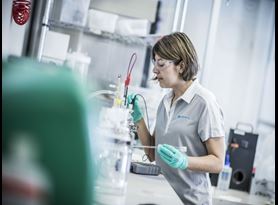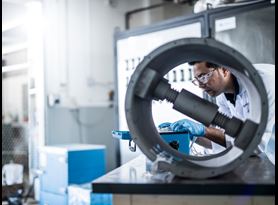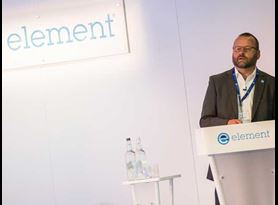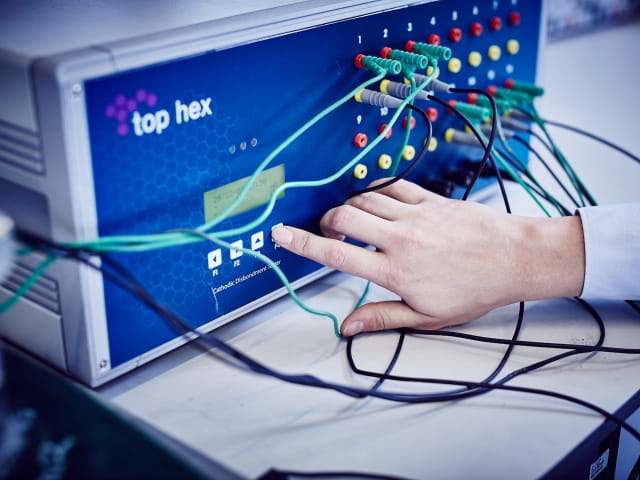Element offers galvanic corrosion testing to ASTM G71, ASTM G82 and to client-specific standards for evaluating the behavior of metals and metallic coatings in accelerated corrosion environments. We can help you select appropriate materials at the design stage and offer in-field support for fast answers in live applications.
What is Galvanic Corrosion Testing and why is it Essential?
Galvanic corrosion is a natural electrochemical process that occurs when two different metals come into contact with an electrolyte, such as sea water. When this happens, one metal becomes the anode, and the other becomes the cathode. The anodic metal corrodes more quickly, while the cathodic metal corrodes slower than usual (or may not corrode at all).
Galvanic corrosion testing is essential to assess the potential risk of damage to metal structures and equipment. By understanding the galvanic corrosion potential of different metal combinations, you can take preventive measures to mitigate or eliminate the risk of corrosion, ensuring the longevity and safety of materials.
Benefits of Galvanic Corrosion Testing with Element
- Meet Compliance Requirements: Gain an in-depth understanding of how materials behave in specific conditions to ensure that your products and structures meet industry standards and compliance regulations.
- Select Appropriate Materials, First Time: Our experts provide comprehensive data on the compatibility and longevity of different metal combinations, helping guide appropriate material choices. These galvanic corrosion testing methods and analyses ensure that your chosen materials will effectively withstand the intended end-use conditions and requirements.
- Benefit from Data-driven design and engineering: Galvanic Corrosion testing offers valuable data on the behavior of metals and metallic coatings in various environments. This data is instrumental in your design and engineering process, allowing for informed decision-making regarding material selection and application suitability.
- In-field Support: We provide in-field support and fast answers to address any of your live application concerns, enabling real-time solutions to mitigate any potential issues related to galvanic corrosion. This support ensures that you can take proactive measures as and when needed.
Reduce Costs
Our galvanic corrosion testing can help you develop more efficient and cost-effective corrosion protection strategies by providing crucial data on the behavior of different metal combinations in specific environments. By understanding the galvanic corrosion potential of various metal combinations, you can take proactive steps to mitigate or eliminate the risk of corrosion, ensuring the longevity and safety of materials. This informed approach leads to more efficient and cost-effective corrosion protection strategies as it minimizes the need for reactive maintenance and costly repairs caused by unexpected corrosion issues.
Tailored Testing Methods
Our extensive range of testing methods, including the ability to test to a variety of standards such as ASTM G71 and ASTM G82, allows us to customize our testing to meet your specific requirements. Our corrosion testing laboratories can replicate a material's condition, environment, and geometry as closely as possible to the application, simulating a galvanic corrosion scenario in the environment of interest. Through galvanic testing, we can assess the interaction between different metals and coatings, enabling you to identify potential corrosion issues and enhance the overall performance and durability of your products.
Our Galvanic Corrosion Expert
Our Galvanic Corrosion Test Methods and Capabilities
Our leading corrosion testing laboratories carry out galvanic corrosion testing on combinations of metals and metallic coatings to evaluate the damage due to galvanic corrosion. We can assist you in selecting the right materials combinations for your required application.
- Galvanized steel
- Copper
- Bronze
- Copper-nickel
- Stainless steel
- Aluminum
- Aluminum/zinc coating on steel
- Tin/zinc alloy coating over stainless steel
- Tin/zinc alloy coating over copper
- Welds (preferential weld corrosion)
Support your Galvanic Corrosion Testing with Electrochemical analysis
Element's Engaged Experts perform electrochemical corrosion testing analysis to evaluate galvanic corrosion performance of two or more dissimilar metals when electrically connected in a selected environment using three main test categories:
- Sensitive galvanic current measurement using Zero Resistance Ammetry (ZRA)
- Galvanic series determination
- Preferential weld corrosion
Why Choose Element?
Element's galvanic corrosion testing services deliver critical insights into the performance and durability of your materials and components under real-world conditions. Our rigorous testing ensures your materials are of the highest quality, safety-compliant, and perfectly suited to their intended purpose. We conduct galvanic corrosion testing according to ASTM G71, ASTM G82, and your specific standards, assessing how metals and metallic coatings behave in accelerated corrosion environments. By partnering with us, you'll benefit from expert material selection guidance during the design phase and responsive in-field support for live applications. Contact our experts today to learn more or request a quote.
FAQ: What is Hydrogen Embrittlement?
Discover hydrogen embrittlement as Vikram Nanda, an expert in metallurgy and metallurgical failure analysis, provides answers to commonly asked questions in this article.
Read MOREPredicting component life with corrosion modeling
Erosion within oil and gas pipelines is a serious problem. Corrosion modeling using the Computational Fluid Dynamic method can accurately predict the location of burn-throughs.
Read MoreIntergranular Corrosion Testing: An Overview of ASTM A262
ASTM A262 is a common intergranular corrosion testing method that can quickly screen batches of material to determine corrosion susceptibility. The ASTM A262 testing specification contains five unique intergranular corrosion tests.
LEARN MOREOther Energy Services
More from Element

Electrochemical Corrosion Testing
Element provides electrochemical corrosion testing using Electrochemical Impedance Spectroscopy, cyclic potentiodynamic polarization measurements and galvanic corrosion measurements.

Sour Service Corrosion Testing
Element is one of a few ISO certified sour service labs in the world, providing sour service corrosion services for a variety of test types including NACE MR0175/ISO 15156.

Resources
Discover blog posts, articles, white papers, webinars, and advice from our world-leading testing, inspection, and certification experts.

Element Locations
Learn more about our laboratories - where they are located; the unique capabilities they have and how they can help you solve your technical and commercial challenges.


